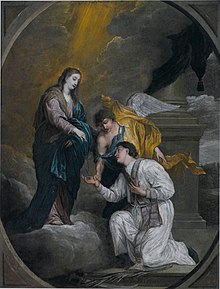David Teniers III
Originally destined for an ecclesiastical career, David III showed such an aptitude for drawing and painting as a collaborator of his father that he chose to become a painter.
[5] His father sent him to Madrid in 1661 with a letter of recommendation from Luis de Benavides Carrillo, Marquis of Caracena, then governor of the Southern Netherlands.
David Teniers III kept a record of his household's incomings and outgoings, which has been preserved and carries the title Handtboeck daer in staedt gespecificeert alle goederen ende gronden van erven, renten ende obligatiën, competerende aen d' Heer david teniers ende myne Huysvrouw, J. Anna Maria Bonnarens, die getrouwt zyn den 4.
Augustus, 1671 (Manual in which are specified all assets and funds inheritances, annuities and obligations belonging to Mr. David Teniers and his housewife Anne-Marie Bonnarens, who married on 4 August 1671).
He is stylistically close to the elegance of Anthony van Dyck or Gonzales Coques but remained thematically closer to the genre scenes painted by his father and grandfather.
His main contribution here is the cartoons for genre scenes executed in the family tradition for tapestries, which were woven in the workshops of Brussels and Lille.


